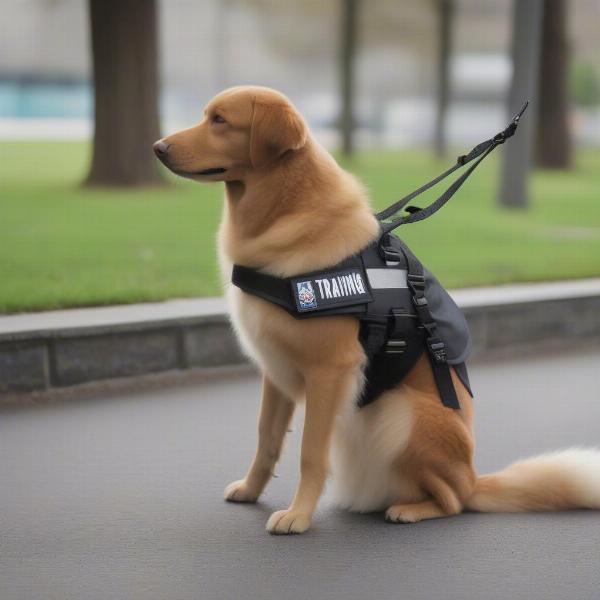An in training vest for dogs is a crucial tool for communicating your dog’s status to the public, especially during crucial socialization and training periods. Whether your dog is a service dog in training, a therapy dog, or simply learning basic obedience, a vest can signal to others to avoid distractions and allow your dog to focus. This guide will delve into the benefits, types, and proper usage of in training vests for dogs.
Why Use an In Training Vest?
An in training vest serves multiple purposes, benefiting both the dog and the handler. For the dog, it acts as a cue to focus and behave professionally. The vest itself can become a conditioned stimulus, associated with training sessions and expected behaviors. For the handler, the vest provides a clear, non-verbal way to communicate the dog’s status to the public. This can prevent unwanted interactions, such as petting or approaching, which could disrupt the dog’s training. It also promotes public awareness and understanding of service dogs and their important role.
Different Types of In Training Vests
Several types of in training vests are available, each with unique features and benefits. Some are made from durable, weather-resistant materials suitable for outdoor training in various conditions. Others are lightweight and breathable, ideal for indoor sessions or warmer climates. Reflective vests are crucial for nighttime visibility and safety. Consider the dog’s size, breed, and training environment when selecting a vest. Adjustable straps ensure a comfortable and secure fit.
 Various in training vests for dogs
Various in training vests for dogs
How to Use an In Training Vest Effectively
Introducing the vest gradually is essential. Begin by letting your dog sniff and investigate the vest, associating it with positive experiences like treats or praise. Start with short periods of wear, gradually increasing the duration as your dog becomes more comfortable. The vest should be snug but not restrictive, allowing for full range of motion. During training sessions, reinforce desired behaviors while the dog is wearing the vest, further strengthening the association between the vest and focused work. Remember, the vest is not a magic solution; consistent training and socialization are key to a well-behaved dog.
Choosing the Right In Training Vest for Your Dog
When choosing a vest, prioritize comfort and functionality. The vest should fit well, allowing for easy movement and breathing. Durable materials are essential, especially for dogs who train outdoors. dogs with hair over their eyes might require special considerations regarding vest design and fit. Ensure the vest is clearly marked with “In Training” or a similar designation to communicate the dog’s status to the public.
“A well-fitting vest can significantly enhance the training process,” says Dr. Emily Carter, a certified professional dog trainer. “It provides a visual cue for the dog and helps manage public expectations, creating a more conducive learning environment.”
Maintaining Your Dog’s In Training Vest
Regular cleaning is necessary to keep the vest hygienic and in good condition. Follow the manufacturer’s instructions for washing and drying. Inspect the vest regularly for wear and tear, replacing it as needed to ensure optimal visibility and functionality. For dogs who train in challenging environments, consider a vest with reinforced stitching and durable materials. “Just like any other piece of dog equipment, regular maintenance will extend the lifespan of your in training vest,” adds Dr. Carter. “Keeping it clean and in good repair also ensures its effectiveness in communicating your dog’s status.”
Conclusion
An in training vest for dogs is a valuable tool that can significantly improve the training process by providing a clear visual cue to the public and fostering a focused learning environment for the dog. By understanding the different types of vests available and using them effectively, you can enhance your dog’s training and promote public awareness of working dogs. Choosing the right vest and maintaining it properly will ensure its long-term effectiveness. Remember, combining the vest with consistent training and positive reinforcement is crucial for achieving your training goals.
FAQ
- Do all dogs in training need a vest? Not all dogs require a vest, but it can be particularly beneficial for service dogs, therapy dogs, and dogs undergoing intensive obedience training.
- Can I make my own in training vest? While possible, purchasing a professionally made vest often ensures better visibility and durability.
- How long should my dog wear the vest? Start with short periods and gradually increase the duration as your dog becomes comfortable. Avoid leaving the vest on for extended periods when not training.
- What should I do if someone approaches my dog while wearing the vest? Politely explain that the dog is in training and ask them not to distract the dog.
- Where can I buy an in training vest? Pet supply stores, online retailers, and specialty dog training websites offer a wide selection of in training vests.
- What are the legal requirements for in training vests? Regulations vary by region; check local laws regarding service dog vests and identification.
- Can I use an in training vest for my pet dog? Yes, you can use an in training vest for any dog, but be mindful of potential misinterpretations by the public if your dog is not a service dog in training.
Related Articles:
- dog vest for service dogs in training
- underground dog fence for large dogs
- dogs on roads
- dog ghostbuster costume
About ILM Dog
ILM Dog is your go-to resource for expert advice on all aspects of dog care and training. We offer a wealth of information on dog breeds, health, nutrition, training, and much more. From puppy care to senior dog support, we cover everything you need to know to be the best dog owner you can be. Whether you’re looking for advice on choosing the right breed or need help with dogs on roads, our expert articles provide practical and reliable information. Contact us at [email protected] or +44 20-3965-8624 for any inquiries.